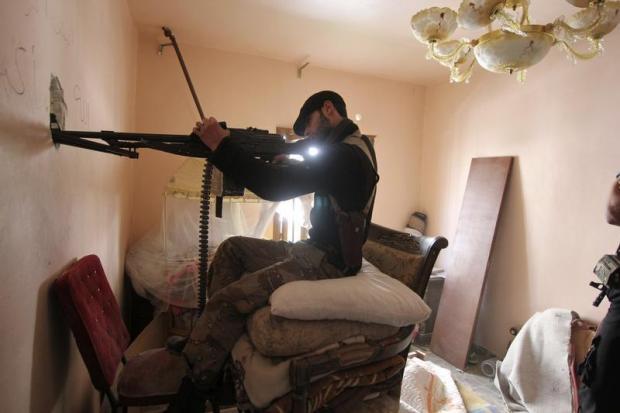Reuters selected this photograph as its best of the day, and it is indeed striking. But why?
The caption said, “A Free Syrian Army fighter takes position inside a room as he points his weapon through a hole in Aleppo’s Saif al-Dawla district March 20, 2013.” And that is what he is doing: positioning himself. Hardly a dramatic action, and it is occurring in a still, spare, beige room, hardly a dramatic setting.
The room is no longer being used for its intended purpose, and a prior time of disruption is evident in the disordered decor: curtains down, furnishings strewn about, a hole punched in the wall. It hardly seems fitted to its new use, however, for that delicate, foofoo lamp will never qualify as military hardware. Yet “irony” seems too easy a label, as it can’t account for the way the soldier dominates the room. Something important is happening, but what?
The sense of stasis is one clue: he is being posed for us, so that we can slow down and look carefully. This is the opposite of an action photo, for the point of his positioning and aiming and firing that enormous weapon is still to come, involving an event that will occur outside the frame. Instead, the point of the photograph is reflection, as if he has gathered into that space an equal and opposite concentration of energy to balance the impending gunfire.
The next clue is the way that he has repurposed the furniture. Arranging the chairs and stacking the pillows to create his makeshift pillbox, he has given the room the same degree of thoughtfulness that went into its original decoration. And he could do it with the same degree of cool concentration, perhaps taking his time to try out different configurations of the pillows, because he already is thoroughly at home in the business of war.
Which gets to the third clue: the natty self-possession in the way he is dressed. You can expect to see that sweater and coveralls in next year’s fashion shows, and the beret could belong on any craftsman as he was making a cabinet or a musical instrument or a book. Forget the camouflage, and a whole life could be surmised from his clothing and concentration; he’s even wearing a wedding ring.
Which brings us back to the room: it, too, represented a way of life, but one that now is being destroyed. And so the deep intelligence of the photo emerges: it is documenting nothing less than how war not only destroys people and things, but also remakes the world in its own image. This is the genius of war: it captures and rechannels the same skills, energies, and capabilities that otherwise are used to sustain peaceful, civil societies.
Force alone can do a lot of damage and thus can account for much of war’s power, but that still is the least of it. As Chris Hedges observed, “war is a force that gives us meaning.” What the photograph above reveals is just how thorough and nuanced that makeover can be, not least because of how it is accomplished by giving ordinary people practical tasks.
Kenneth Burke once observed that war motivates extreme levels of cooperation, albeit on behalf of the worst forms of competition. (That is irony, and more than that.) War also can motivate rearranging a living room on behalf of killing. As the war “progresses,” the fighters can find themselves wholly occupied, engaged, and fulfilled by the work of destruction. Why not: it rewards their resourcefulness.
This is the challenge that peace has to meet.
Photograph by Giath Taha/Reuters.

[…] War’s Bricolage (No Caption Needed) […]
[…] War’s Bricolage (No Caption Needed) […]
[…] War’s Bricolage (No Caption Needed) […]
[…] War’s Bricolage (No Caption Needed) […]